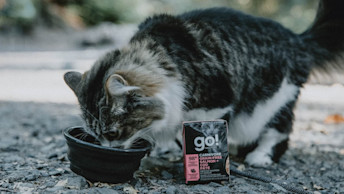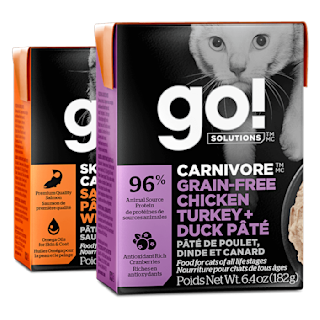August 13, 2021
Should You Feed Your Cat Wet Food?

When choosing the best food for our furry felines, many pet parents aren't sure exactly where to start. With various options on the market such as kibble, wet food and freeze-dried, where does one begin? While all have their benefits, wet food for cats is a great way to add variety to your cat's current diet and provides many health benefits!
Wet Food Versus Kibble
As they say, variety is the spice of life, and wet food is a terrific way to accomplish this for your cat's diet. Wet food comes in many different formats – stew, shredded, minced and pâté. It also comes in a variety of packaging options to suit your lifestyle. One of the newest packaging options, Go! Solutions Tetra Paks, is a sustainable, convenient, easy-to-use, and resealable carton.

Recommended Solution
Pocket-Sized Paks of Solutions-Based Nutrition
Formulated to provide solutions for cats’ unique dietary needs including picky eating, dandruff or dull coat, and food allergies or sensitivities.
View wet food recipes
As the name suggests, the moisture content of wet food is much higher than kibble. While kibble contains 8-12% moisture, wet food can run as high as 82% moisture! To learn more about the nutrient profile values, see these on our recipe pages.
Another differentiator between kibble and wet food is that unlike kibble, which requires carbohydrates to help create a crunchy texture, wet food can be formulated with lower levels of carbohydrates. Because of this, wet food recipes generally include higher amounts of meat, allowing for increased levels of protein and fat and lower levels of carbohydrate compared to kibble. Recipes like our Go! Solutions Carnivore Grain-Free Chicken, Turkey + Duck Pâté makes for the perfect recipe for those carnivorous cats! Therefore, wet food makes an excellent option for cats who may require a higher protein, lower carbohydrate diet.
Benefits of Wet Food for Cats
Wet food is highly palatable, so it's an excellent option for those picky eaters. It's also ideal for cats experiencing dental issues that may require a soft diet.
Cats are known to have difficulty with regular water intake, and in many cases, they don't drink enough. Wet food is great for this due to its high moisture content. Because wet food is generally 78-82% moisture, it's a great way to ensure increased hydration. Additionally, increasing your cat's fluid intake can help to prevent the development of urinary tract crystals.
Choosing a Wet Food for Your Cat
When choosing a wet food, be aware that not all wet foods are appropriate to be fed as the only source of nutrition. Therefore, it's essential to make sure to read the nutritional adequacy statement on the carton beforehand.
If the food states that it's "formulated to meet the AAFCO nutrient profiles for
a given lifestage", it's complete and balanced and can be fed as a cat's primary source of nutrition.
Tip: Wet foods can also be used as a healthy treat option. Rest assured that all GO! SOLUTIONS wet food recipes are formulated to be complete and balanced, to help your kitten, adult or senior cat remain healthy and happy!
How to Add Wet Food to Your Cat's Diet
Your cat's diet can include wet food in multiple different ways. Keep in mind that if you decide to feed wet food as a topper to kibble, it's important to cut back on the amount of kibble you're currently providing to avoid excess weight gain. If you're unsure whether or not you're feeding the right amount of food to your cat, you can always check with your veterinarian or check our our body score chart.
Additionally, if you are using wet food as a treat, there are many unique ways to incorporate it, such as freezing the food in ice cube trays for a cool treat in the hot summer months!
Cats can be notoriously fussy eaters. Many cats who are used to eating dry food daily can be a challenge to have them accept new flavours and textures. This is usually because cats are sensitive to texture and flavour and often tend to stay away from things they are not used to. Therefore, it's crucial to expose your cat to a wide variety of textures and flavours of wet food, especially at a young age. Kittens that have been given a wide variety of textures may be less inclined to be fussy in adulthood.
Keep in mind that if switching from kibble to wet food, a slow transition is important. If transitioning your cat to a diet they have not tried before; it should be done slowly over a minimum of 10 days. This will help ensure their system has had a chance to adapt to the change and avoid digestive upset.
However, with a bit of trial and error, we're sure you will find something both your furry feline and you - will love!



